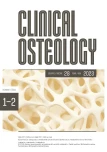Exostosis of proximal femur – benign tumor, “malign” location: a case report
Authors:
Rendek Pavol 1; Kokavec Milan 1; Chládek Petr 2
Authors place of work:
Ortopedická klinika LF UK a NÚDCH, Bratislava
1; Ortopedické oddělení, Vršovická Zdravotní, a. s., Praha
2
Published in the journal:
Clinical Osteology 2023; 28(1-2): 31-33
Category:
Kazuistiky
Summary
Osteocartilaginous exostosis, also called osteochondroma, is a benign bone tumor for most localized near the epiphyseal plate. It is the most common bone tumor, representing about 20–50 % of all benign bone tumors. Its radiological image is very typical – it is most often a pediculate formation with a cartilaginous cap. Osteochondromas can be solitary, cases of multiple occurrence are called hereditary multiple enchondromatosis (HME). Histologically it is categorized as a benign affection, clinically presenting with pain, a local palpable mass and restriction of movement. Histological malignization of the tumor is rare, reported in 1 % of cases. In the tumor can however be considered malignant in cases of adverse localization. In this article we present the case of a 15-year-old boy with an exostosis of the proximal femur with a prominent ischiofemoral impingement syndrome. After a biopsy and a partial resection, the tumor was treated via the surgical hip dislocation technique, which allows access to the femoral head without compromising its nutritional blood vessels. After a radical resection, the patient has been monitored for 4 years and his clinical and radiological condition is satisfactory.
Keywords:
proximal femur – surgical hip dislocation – exostosis – osteochondroma
Zdroje
1. Scarborough MT, Moreau G. Benign cartilage tumors. Orthop Clin North Am 1996; 27(3): 583–589.
2. Wang SK, Park BM. Induction of osteochondromas by periosteal resection. Orthopedics 1991; 14(7): 809–812. Dostupné z DOI: <http://dx.doi.org/10.3928/0147–7447–19910701–16>.
3. Karasick D, Schweitzer ME, Eschelman DJ. Symptomatic osteochondromas: imaging features. AJR Am J Roentgenol 1997; 168(6): 1507–1512. Dostupné z DOI: <http://dx.doi.org/10.2214/ajr.168.6.9168715>.
4. De Beuckeleer LH, De Schepper AM, Ramon F. Magnetic resonance imaging of cartilaginous tumors: is it useful or necessary? Skeletal Radiol 1996; 25(2): 137–141. D ostupné z DOI: < http://dx.doi.org/10.1007/s002560050050>.
5. Murphey MD, Choi J, Kransdorf MJ et al. Imaging of osteochondroma: Variants and complications with radiologic-pathologic correlation. Radiographics 2000; 20(5): 1407–1434. Dostupné z DOI: <http://dx.doi.org/10.1148/radiographics.20.5.g00se171407>.
6. Humbert ET, Mehlman C, Crawford AH. Two cases of osteochondroma recurrence after resection. Am J Orthop (Belle Mead NJ); 2001: 30(1): 62–64.
7. Siebenrock KA, Ganz R. Osteochondroma of the femoral neck. Clin Orthop Relat Res 2002; (394): 211–218. Dostupné z DOI: <http://dx.doi.org/10.1097/00003086–200201000–00025>.
Štítky
Biochemie Dětská gynekologie Dětská radiologie Dětská revmatologie Endokrinologie Gynekologie a porodnictví Interní lékařství Ortopedie Praktické lékařství pro dospělé Radiodiagnostika Rehabilitační a fyzikální medicína Revmatologie Traumatologie OsteologieČlánek vyšel v časopise
Clinical Osteology

2023 Číslo 1-2
Nejčtenější v tomto čísle
- Exostóza proximálneho femuru – benígny nádor, „malígna“ lokalita: kazuistika
- Osteoporóza počas gravidity
- Zamyšlení nad příčinami senilní osteoporózy
- Jak a čím žije česká klinická osteologie v dnešní době
